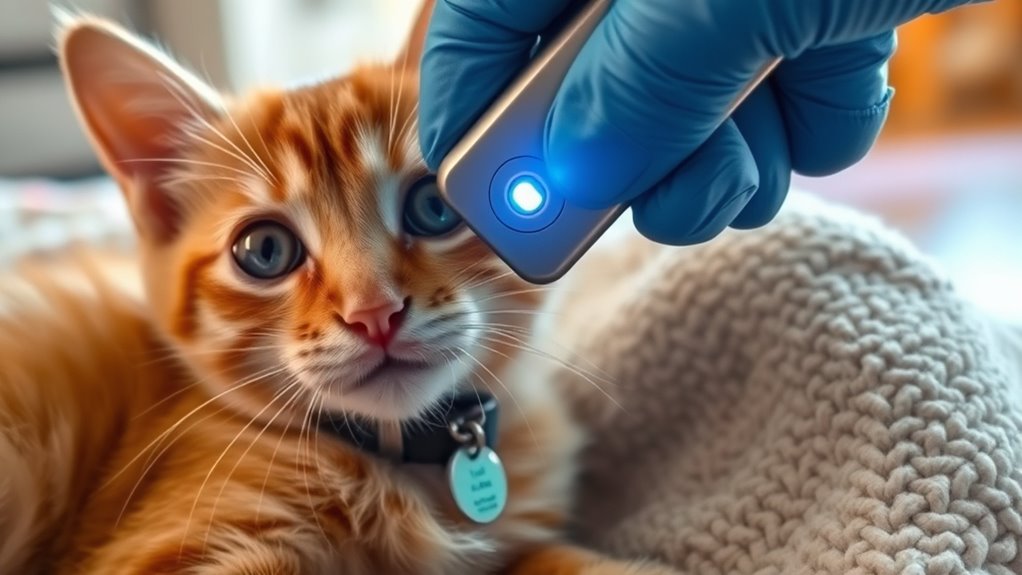Microchipping and ID tags are key to safeguarding your pets during disasters. They help guarantee your pets can be quickly identified and returned if they become lost or separated. ID tags are visible, carrying your contact info, while microchips provide a permanent form of identification that’s less likely to be lost or removed. Together, these tools speed up recovery and increase the chances of a safe reunion. To learn how to best protect your pets, keep exploring these essential safety measures.
Key Takeaways
- Microchipping provides permanent identification that can’t be lost or removed, ensuring long-term pet safety during disasters.
- ID tags display immediate contact information, enabling quick reunions with owners in emergency situations.
- Combining microchips and ID tags maximizes the chances of pet recovery during chaos and displacement.
- Proper identification reduces shelter time and helps rescue efforts locate owners swiftly.
- These identification tools are essential safety measures to protect pets during emergencies and disasters.

Microchipping and ID tags are essential tools for keeping your pets safe and easily identifiable. During emergencies or disasters, these identification methods can make all the difference in reuniting you with your furry friend. When chaos strikes, your pet’s safety depends heavily on quick and accurate identification, especially if they become separated from you. Emergency shelters often become overwhelmed with displaced animals, and staff there rely heavily on visible tags or microchips to quickly identify pets and contact owners. Without proper identification, your pet could spend hours or even days in a shelter without anyone knowing who they belong to. Having your pet microchipped or fitted with an ID tag ensures that if they get lost amidst the confusion, there’s a higher chance they’ll be returned to you swiftly.
Microchips are a permanent form of identification that, when registered correctly, provide a simple way for shelters, veterinarians, or rescue workers to retrieve your contact details. Unlike collars or tags, which can fall off or be removed, microchips remain embedded under your pet’s skin, offering a reliable, long-term solution. In a disaster scenario, where your pet might be injured or frightened, a microchip can be a vital link to your information. Many emergency shelters prioritize microchipped animals for lost pet recovery because they’re easier to identify, especially when pets are scared and less likely to wear or keep tags on.
Microchips offer a reliable, long-term ID solution, helping shelters identify and reunite lost pets quickly.
ID tags are a quick, cost-effective way to give your pet immediate identification. They’re visible and can carry your phone number, address, or other contact details, allowing someone who finds your pet to reach you right away. During an emergency, this immediate contact can facilitate swift reunions. Keep your tags updated, especially if you move or change your phone number, so that your pet can always be returned promptly. Some shelters and rescue groups even recommend combining microchipping with ID tags for maximum security.
In the chaos of a disaster, your pet’s chances of being recovered increase considerably when they’re properly identified. Emergency shelters are often overwhelmed, and staff rely on these identifiers to quickly match pets with their owners. Because lost pet recovery becomes more challenging without proper identification, taking the time to microchip your pet and ensure they wear current ID tags is a crucial step in safeguarding their well-being. Ultimately, these simple tools can save your pet’s life and bring peace of mind, knowing you’ve taken the necessary precautions for their safety during any crisis.
Frequently Asked Questions
How Often Should Microchip Information Be Updated?
You should update your microchip registration and pet records at least once a year or whenever your contact information changes. Keeping your microchip details current guarantees you can quickly reunite with your pet if they get lost during a disaster. Regular updates help shelters and microchip databases contact you without delay, safeguarding your pet’s well-being. Make it a habit to review and update your pet’s information regularly for peace of mind.
Are Microchips Safe for All Pet Ages?
Think of microchips as tiny, silent guardians nestled beneath your pet’s skin. They’re safe across all pet ages, like gentle shadows that adapt to your furry friend’s size and health. Microchip compatibility guarantees they suit your pet’s age considerations, from playful puppies to wise old tails. Rest assured, these microchips are designed with safety in mind, becoming a seamless part of your pet’s lifelong journey.
What Should I Do if My Pet’s ID Tag Gets Lost?
If your pet’s ID tag gets lost, act quickly to guarantee their safety. Start with lost pet recovery by posting flyers and online notices, and notify local shelters. Contact your vet or the tag manufacturer for ID tag replacement options, and consider microchipping as a permanent solution. Keep your contact info updated and make sure your pet wears a collar with a visible ID tag at all times to prevent future issues.
Can Microchips Be Removed or Tampered With?
A stitch in time saves nine, and that’s true for microchips too. While tamper prevention measures make it hard, microchips can technically be removed or tampered with, so they’re not foolproof. Modern microchip durability helps prevent easy removal, but determined individuals might still try. To keep your pet safe, combine microchipping with ID tags and regular checks. Stay vigilant—no method is completely foolproof, but layered protection offers the best safeguard.
How Do I Register My Pet’s Microchip?
To register your pet’s microchip, you need to contact the microchip manufacturer or a pet recovery program that uses microchip technology. Provide your contact details and your pet’s information to guarantee they’re linked correctly. Many pet recovery programs offer online registration options. This step helps reunite you quickly if your pet gets lost, as most shelters and vets check microchips using dedicated scanners.
Conclusion
By microchipping and using ID tags, you guarantee your pet’s safety even during disasters. Some might think it’s unnecessary or expensive, but the peace of mind knowing your furry friend can be quickly identified outweighs the small effort or cost. If disaster strikes, these simple steps make all the difference in reuniting you with your pet fast. Don’t wait—protect your pet today, because their safety is worth every small step.









